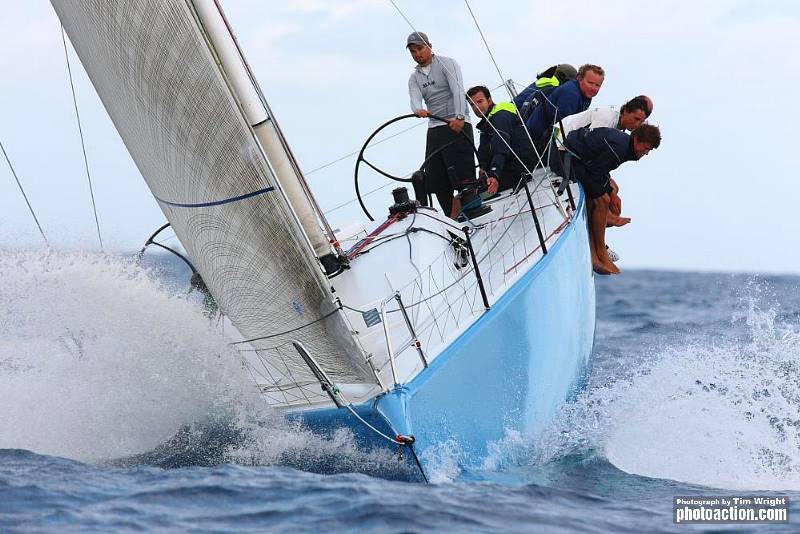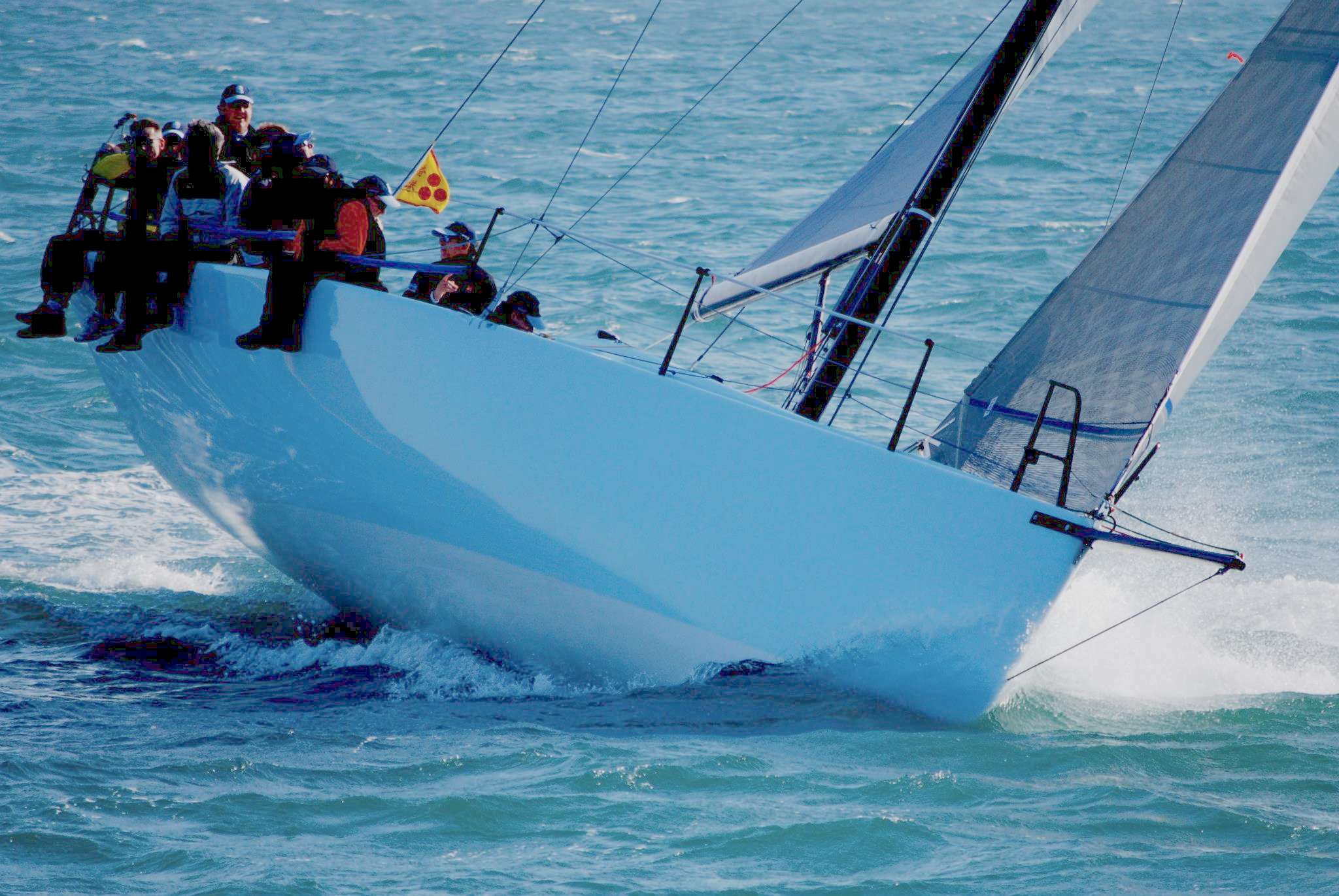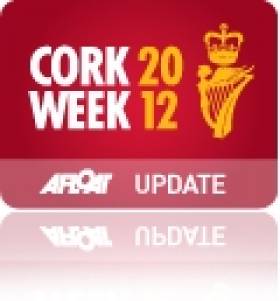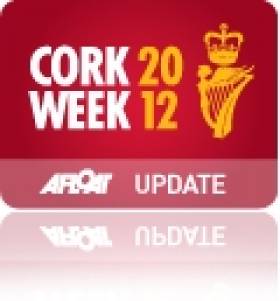Displaying items by tag: cork week 2012
#corkweek – Former Round Ireland champion Piet Vroon's Dutch Ker 46, Tonnerre de Breskens won both of today's opening races at Cork week 2012 writes Louay Habib.
There was a gentle but unpredictable start to Cork Week 2012 today when a shifty northwesterly breeze of between 8-12 knots blew for the international fleet at Cork Week at Crosshaven.
Local entry, a Corby 38 Gloves Off, skippered by Kieran Twomey scoring two podium finishes to end the day second in class to Vroon.
A tie for third place in race 2 typified the intense battle in the big boat class. Michael Bartholomew's South African Mills 40, Tokoloshe and Jamie McWilliam's Ker 40, Peninsular Signal 8 from Hong Kong, could not be separated after time correction.
The tight Olympic and Trapezoid courses provided some close encounters, with plenty of close boat on boat action. However, reading the changes in both the wind direction was vital to success. As the day progressed the wind became less stable with a fresh front arriving later in the afternoon, giving a damp finish to a day of hot racing.
In IRC One the day was emphatically won by Richard Fildes' Corby 37, Impetuous, which won both of today's races. Richard sails out of Abersoch, Wales and is a veteran of Cork Week.
"I have been coming here since 1979 and this is my 12th trip on the trot but I have to say that is the best day I have ever had here!" Laughed Richard. "Great competition on the water and I have to admit to getting a thick slice of luck. Inga of Sweden was going so well in the first race but got slowed down by a boat in another class, which definitely helped us and in the second race, I have to admit we were late to the restart and crossed at the Committee boat by chance rather than judgement and plugged into a really useful shift, which really made the win."
In the 1720 Class, Jane McLelland's Girls Antix, with Libby Greenhalgh at the helm, won the first race of the day and after two races the girl's team are level on points with Denis Murphy's Aquatack. Jane is the mother or two young children that are back home in London with their father. "Well what a fantastic day!" Smiled Jane. "The decisive moment in the first race came when we saw that the leading boats were slowing down in a luffing match and we managed to sail around them. But I have to say it was a totally unexpected win, I haven't been out racing for ages and we are all a bit rusty but what a great way to start Cork Week!"
In IRC Three, Peter Deasy, Admiral of the Royal Cork Yacht Club took the win in the only race of the day with his Sunfast 32, Bad Company. "We didn't have the best start but we spotted a shift and made an early tack onto it, which proved decisive." Commented Deasy. "But we were made well aware of some great sailors in this class, especially Dermot Foley's Anchor Challenge. We will have a glass in the club tonight but we will be keeping our powder dry for another battle tomorrow."
Local weather expert, Eddie English believes that conditions for tomorrow's racing may be fairly similar to today with perhaps a slight shift to NNW with maybe a knot or two more pressure.
Cork Week Day One Top 3 Results Class by Class:
IRC0:
1 TONNERRE DE BRESKENS 3 Peter Vroon
2 GLOVES OFF Kieran Twomey
3 TOKOLOSHE Michael Bartholomew
IRC1:
1 IMPETUOUS Richard Fildes
2 INGA II FROM SWEDEN Richard Goransson
3 JUMP JUICE Conor Phelan
IRC2:
1 D-TOX Donal O'Leary
2 SOMETHING ELSE J Hall, S McDonnell & B Hall
3 JALAPENO Baker et al
IRC3:
1 BAD COMPANY Peter Deasy
2 ANCHOR CHALLENGE Dermot Foley
3 AURORA Ronan Lyden
IRC4:
1 OUTRIGGER J Nyhan & M Buwalda
2 POLISHED MANX Kuba Szymanski
3 EXCELLE Toby Claridge & J. Fox
J109:
1 SOMETHING ELSE J Hall, S McDonnell & B Hall
2 JALAPENO Baker et al
3 JELLY BABY Ian Nagle
1720:
1 AQUATACK Denis Murphy
2 GIRLS ANTIX Jane McLelland
3 WAHOO Finbarr Jeffers
IRC Non Spinnaker 1:
1 XERXES Dan O'Neill
2 DIAMONDS ARE FOREVER Anne O'Sullivan
3 IMPETUOUS Tim Brouard
IRC Non Spinnaker 2:
1 MINX III Sigma 33 Tom NcNeice
2 MINSTREL Hunter Sonata John Patrick Hayes
3 XTENSION X Yacht 372 Conor O'Donovan
Hong Kong, Holland and South Africa Entries Boost Cork Week
#CORK WEEK – South Africa's Tokoloshe, Holland's Tonnerre de Breskens, Hong Kong's Signal 8 and Ireland's own Ker 39 Antix will make up one of the most competitive class zero divisions for Cork Week in many years and the early news such an international line up is bound for Cork Harbour is a major advance for Crosshaven organisers, Royal Cork Yacht Club.
From Cape Town, South Africa Mike Bartholomew will be racing at Cork Week with his Mills 40, Tokoloshe. The sleek blue hull has been tremendously successful and was in fine form last year, winning the prestigious Britannia Cup at Cowes week. A previous winner of at the Scottish Series and RORC Easter Challenge, Tokoloshe has a fine racing pedigree and represented South Africa in the 2010 Rolex Commodores' Cup.

South Africa's Tokoloshe is heading for Cork Week in July
Mike Bartholomew explains why he is returning to Cork Week having missed the 2010 edition.
"At the start of the year, we planned out our season and Cork Week wasn't going to feature. However, we have changed our plans and will be in Crosshaven in July. The reason behind it is the relaxation of the rules about sailors classed as professionals. Tokoloshe is based in Hamble and most of the crew live in the village and work in the marine industry. None of them are paid to sail on Tokoloshe but because they are classed by ISAF as pros, this caused a major problem when entering Cork Week. I am delighted that the rules have been relaxed because we love coming to Cork Week, fantastic racing and a great atmosphere ashore, it really does tick all the boxes."
From Breskens, Holland Piet Vroon will be racing his Ker 46, Tonnerre de Breskens. 2010 RORC Yacht of the Year and Overall Round Ireland winner, Tonnerre has been one of the most successful yachts on the international racing circuit. Piet is now in his 80s and knows a thing or two about yacht racing. He has competed in 26 Fastnet Races, as skipper including last year's record-breaking race. Whilst Piet may well be one of the oldest competitors at Cork Week, his crew is composes of young aspiring sailors but none of them are paid to sail, that is Piet's way.
"I don't care much for the huge parties in the event village after racing but the boys love it. I prefer to relax in the evenings and get recharged for the next day's racing. The race management at Cork Week is first class and the variety of courses is excellent, one big advantage at Cork Week is that, besides the Harbour Course, there is very little tide, which means far better courses than say Cowes Week. I was introduced to Crosshaven by Dennis Doyle many years ago and I have been coming ever since."

Jamie McWilliam returns from hong Kong with Signal 8
From Hong Kong, Cork Week will be welcoming back one of their son's Jamie McWilliam with his brand new Ker 40, Signal 8. The McWilliam family needs no introduction to Cork Week regulars. However, Jamie has lived in Hong Kong for many years and missed out in 2010.
"We plan to bring Signal 8 over to compete in the RORC IRC Nationals in June and we have an extensive programme throughout July with our sights firmly set on the Brewin Dolphin Commodores' Cup but Cork Week is most definitely a must.
The key ingredients to a successful regatta are great courses and excellent race management. There are other regattas that can match the superb range of courses at Cork Week but in my opinion, nobody does it better than Cork Week. If I was going to give competitors one good tip, it would be get some local knowledge on board. Back in 2000 on Swan 48 Jacobite, we were sailing towards the finish, rock hopping under Weaver's Point. Keith MacKeown was on board and his house was just yards from the finish line. Keith was lying on the foredeck with his head over the bow as we went in ducking the bricks, it made one hell of a difference to our result."
From Cape Town, South Africa Mike Bartholomew will be racing at Cork Week with his Mills 40, Tokoloshe. The sleek blue hull has been tremendously successful and was in fine form last year, winning the prestigious Britannia Cup at Cowes week. A previous winner of at the Scottish Series and RORC Easter Challenge, Tokoloshe has a fine racing pedigree and represented South Africa in the 2010 Rolex Commodores' Cup.
From Crosshaven, Ireland's Anthony O'Leary from the host club is delighted to be renewing old rivalries at the helm of his Ker 39, Antix.
"It is fantastic to hear that the South African King 40 Tokoloshe is coming to Cork Week and now that Jamie McWilliam will be bringing Signal 8 all the way from Hong Kong as well, it will make for a very competitive division. We three have been both sides of very close results in recent years and it is bound to be a real struggle on the water. Knowing Mike and Jamie, I am sure there will also be plenty of banter at the yacht club after racing!
To win at Cork Week, you have to race consistently well every day; the variety of courses evens out the design differences between the boats. I have no illusions, winning against good opposition is never easy but it makes racing at Cork Week all the more rewarding."

























































